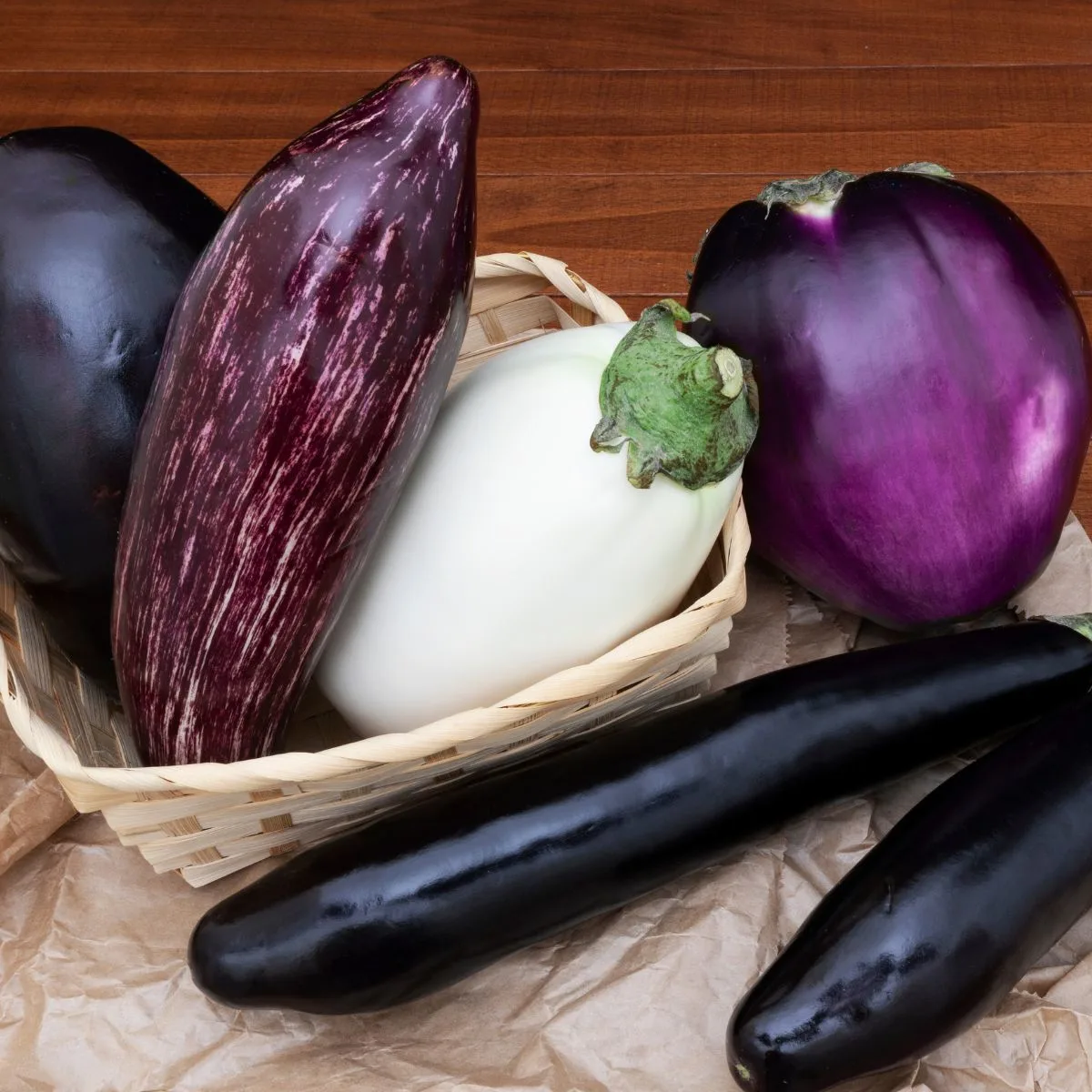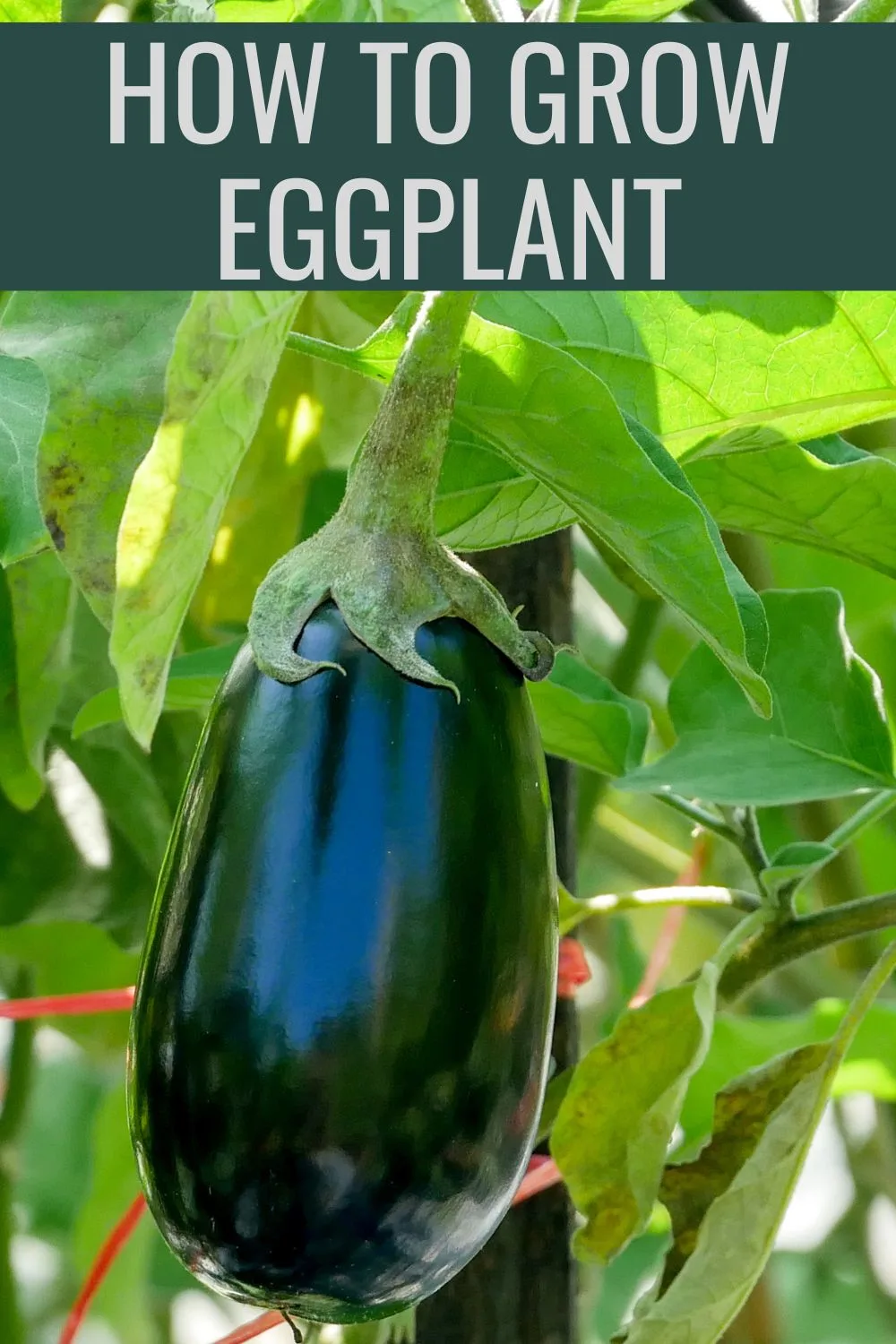Are you wondering how to grow eggplant? A beautiful vegetable with dark fruit, eggplant is a classic in Mediterranean dishes. The glossy purple coloring is so appealing! But remember that eggplants require a long warm season to grow.
There are different varieties of eggplant and this can affect how you grow them, as well as whether you start from seeds or from eggplant seedlings. The purple fruit variety is the most common, but there are also varieties with white or golden skins. There are some things to be aware of, such as the danger of frost, if you want to grow healthy plants. Let’s take a look!

Types Of Eggplant
There are lots of eggplant varieties: the most familiar varieties are those that bear the large, purple, oval-shaped fruit. On store seed racks it’s easy to find varieties such as ‘ Black Beauty,’ Dusky hybrid,’ or ‘early Beauty.’ Long, slender Japanese varieties such as ‘Ichiban’ (it’s purple with a taste similar to oval eggplants) are also common. Rarer are white-skinned ‘ white beauty’ with hen’s egg size fruits and ‘ golden yellow,’ with small saffron-colored fruits.

Here are some varieties of eggplants:
- Japanese eggplants
- Italian eggplant
- Graffiti eggplant
- White eggplants
- Little Green
- Thai
- Fairy Tale Eggplant
Like tomatoes and potatoes, eggplants are a member of the solanum family and need the same growing conditions: rich, loose soil, full sun, and warm to hot temperatures. Most gardeners grow eggplants outdoors in a summer garden but you can try them indoors as well.
How to Grow Eggplant
How to prepare the soil for growing eggplants
Eggplant (also known as aubergine in Europe) grows best in a greenhouse or poly-tunnel, but if you have a garden area that gets at least 8 hours of sunlight daily, plating it in the garden works well too.
Since they are heavy feeders, eggplants need to be rotated from year to year in order to avoid leaching nutrients as well as discourage the build-up of disease when the same crop is sown in the same place year after year.
If you plant any of these on a regular basis, crop rotation may be a bit more difficult, as they are all members of the nightshade group of vegetables, even though they seem to be unrelated:
- potatoes
- tomatoes
- sweet peppers
- hot peppers
- eggplants (aubergines)
Many gardeners deal with this problem by following a soil rotation plan. In year one remove the top six inches of soil and load the garden plot or greenhouse with very well-rotted manure, some leaf mold or garden compost, some shredded paper, and a dressing of fish, blood, and bone. In year two refresh with some more manure, compost and fish, blood and bone, and in the third year repeat year one.
Although this seems like a lot of work, you’ll get the benefit of using the spent soil to add organic matter to other parts of the garden – this helps to improve the soil structure for other plants, and there are still plenty of nutrients left in the soil for other plants to take advantage of.
Add the spent soil to an area of the garden that is furthest away time-wise from having nightshade plants growing. You can add it to the part of the vegetable plot that has just had potatoes growing, as it will be four years before that area supports potatoes again.
Another way to approach this rotation would be to grow in grow bags or pots in alternate years.
You could also alternate each side of the garden each year and use the opposite side for a green manure crop such as broad beans or peas.
Tips for growing eggplants
In the nourishing soil of a garden or large pot, eggplants can reach a height of 2 to 3 feet with an equal width. The lavender flowers appear in early summer and continue to bloom throughout the summer, even while the fruit becomes ripe on the plant.
Warmth is the secret to how to grow eggplants: they love hot weather! To make sure that your fruit ripens during the season, you should sow seeds indoors in February or March. Sow in February in a heated propagator using an 8cm pot, moving them to a poly-tunnel once the first pair of true leaves are well established unless it is very cold.
- Sprinkle eggplant seeds over damp soil – each plant about 2 1/2 to 3 ft apart.
- Cover with a thin layer of potting mix and glass or plastic to conserve humidity.
- Place the seed tray and a warm (70F) location. Seeds germinate quickly – after a few days.
- When the leaves begin to surface, remove the cover, but keep the soil damp.
- Once seedlings reach about 5 to 6 inches in height, move seedlings to their own pots and give them as much light as possible.
A point to remember is that the true leaves are not the first leaves. The first pair of leaves are actually a part of the seed, and the next leaf will be the first true leaf.
As soon as the seedling is well established and healthy, ideally before or during May, transplant them to their final growing position, which will either be a border, a grow bag, or a larger pot.
The eggplant plant can get quite bushy and will need a fair bit of space to grow, so if growing in borders space your plants two to three feet apart, in staggered rows. You might need to use a tomato cage if your plants grow too tall.
It is also a good idea to plant an empty, bottomless milk or pop bottle upside down, next to the plant for watering.
Once the plant has grown to about 10 inches, pinch off the growing tip and wire it to the stake to give it support.
When it starts to flower feed it with a liquid tomato food and mist the flowers to help them set.
Once you have six fruits forming pinch out any more flowers as they bud so that the plant’s energy goes into the six fruits only.
Here are some tips to help you make the most of your eggplant farming.
- Space plants 24 to 36 inches apart and stake them once established. This will help prevent them from toppling.
- Test your soil temperature before planting if you’re still in between seasons and you’re not sure you have warm soil yet. Be sure the soil is above 50 degrees.
- Keep the soil moist but not soggy.
- Improve the quality of your native soil by adding some aged compost or rich organic material.
- Harvest when they stop growing and the skin becomes glossy.
How to grow eggplant in containers
Eggplants are easy to grow in containers, as long as you plant one plant per pot, and your pot is 12 to 14 inches deep and has drainage holes. Add some well-draining, soil-based potting mix, and be sure to fertilize eggplants regularly, as they are heavy feeders. Look for a fertilizer with a high amount of phosphorus, as this will encourage fruiting.
Eggplants should be watered deeply and allowed to dry out somewhat between waterings. Be sure to monitor eggplants closely for signs of pests or disease. You can grow them in containers until harvest, or start seedlings in containers and transplant them later when the weather outside is warmer.
How to harvest eggplant
You can start to harvest aubergines in late summer when they are plump and shiny. Don’t leave them too long and definitely pick them before they lose their gloss as this is when they start to taste bitter.
You should remove the eggplant fruit with sharp gardening shears, leaving a small portion of the stem. If you are not planning to use the eggplant immediately, it can be stored in a cool, dark place for up to a week. With proper care, eggplants can be a delicious and healthy addition to your diet all year round.
Make sure to wear gloves when you pick the fruits as there are some sharp thorns on the stalk, and cut them rather than break them off.
Eggplant Pests and Diseases
Eggplants are fairly trouble-free, there are some common pests that can attack eggplants, such as eggplant flea beetle, whitefly, aphids, or red spider mites.
Misting will help to keep these pests away but if you so get an onslaught, an insecticidal spray will do the trick. You can buy pest control sprays but they are easy to make, just mix about 5 tablespoons of natural soap with a gallon of water, and to deter sap-sucking pests add some chili or garlic.
If you are having trouble with whitefly simply coat a yellow piece of card with syrup and hang it in the greenhouse, the flies are attracted to the yellow and stick to the card.
Eggplants can also be attacked by tomato hornworms. Here’s how to get rid of tomato hornworms naturally.
To avoid the problems altogether plant some French marigolds, coriander, and basil in among your veggies: they will deter most pests. Add some dill to encourage insect predators. Here’s a list of companion plants for eggplant.
Eggplant is also susceptible to verticillium wilt and fusarium wilt, two fungal diseases that can quickly kill the plant.
How to use eggplants in the kitchen
Older varieties of eggplant needed a salt treatment to remove the bitter juice, but these days, as varieties have been improved, there is no need to pre-treat them, just prepare them in the way you would like them.
Probably the most famous dish that uses aubergine is moussaka: slice, fry in oil, and then cool. Using this same method you could also layer them with tomatoes and parmesan cheese to make a classic Italian side dish.
Eggplants can also be used to make soups and in risotto, they can also be stuffed and used as a meaty veg for a curry or tagine, and you could even slice them lengthways, part cook them, and use them as an alternative to lasagna sheets, or cannelloni rolls, great for anyone who can’t eat wheat.
Or, roast them and make eggplant spread: everyone will love it!
No matter how you choose to prepare it, eggplant makes a delicious addition to any meal.




How To Roast Eggplant In The Oven
Tuesday 21st of March 2023
[…] Want an abundance of eggplants through the summer? Here’s how to grow eggplants. […]
7 Best Companion Plants For Eggplant (And 3 To Avoid)
Saturday 21st of January 2023
[…] Learn more about growing eggplants. […]